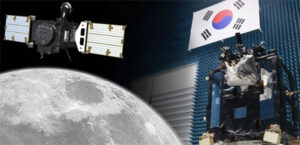Special to CosmicTribune.com, August 5, 2022
A SpaceX Falcon 9 rocket lifted off from Cape Canaveral, Florida on Aug. 4, 2022, with South Korea’s first Moon mission: the Korea Pathfinder Lunar Orbiter, called Danuri. Later missions will include an orbiter, lander, and rover.

Danuri, from the Korean words dal and nurida, means “enjoy the Moon” and its mission calls for scanning the lunar surface for minerals and elements, including aluminum, helium-3, and surface water ice, Sky and Telescope reported.
To accomplish this, the solar-powered spacecraft carries six instruments, one from NASA and five from the Korea Aerospace Research Institute (KARI):
- The Wide-Angle Polarimetric Camera (PolCam) will image and analyze the lunar regolith in polarized light. Though Earth-observing satellites have long used this technique, this is the first time a polarized-light imager has flown to the Moon. Bill Farrand (Space Science Institute) says that he will use PolCam to explore the nature of pyroclastic deposits, which formed early in the Moon’s history during explosive volcanic activity.
- The KPLO Magnetometer contains three sensors that will characterize the magnetic field lines frozen into lunar rocks.
- The Lunar Terrain Imager will take sharp images of future landing sites, resolving features down to just 16.5 feet (5 meters) across.
- The Delay-Tolerant Networking experiment will test a sort of “interplanetary internet” by addressing the technical issues that arise in a communications network that lacks continuous connectivity.
- The Gamma Ray Spectrometer is a gamma-ray spectrometer that works in the 10 kilo-electron volt (keV) to 10 mega-electron volt (MeV) range to probe the surface of the Moon in search of key chemicals and elements.
- The sole NASA instrument, ShadowCam, will hunt for lunar water ice in permanently shadowed regions of the Moon. ShadowCam is 800 times more sensitive than a similar camera on the Lunar Reconnaissance Orbiter.
KARI is a signatory to the Artemis Accords, meaning South Korea could potentially contribute to the common human effort to explore the Moon. KARI first put South Korea in the world spaceflight community in 2013, when its Naro 1 rocket successfully reached low-Earth orbit.
Related: South Korea’s rapid missile advances check North, puts China at risk, August 2, 2022
KARI mounted the operation in partnership with NASA since 2016. The newly installed Korea Deep Space Antenna in Yeoju, South Korea, will also help track Danuri, along with global coverage provided by NASA’s Deep Space Network.
https://www.youtube.com/watch?time_continue=50&v=3IpCSls2D5g&feature=emb_logo

You must be logged in to post a comment Login